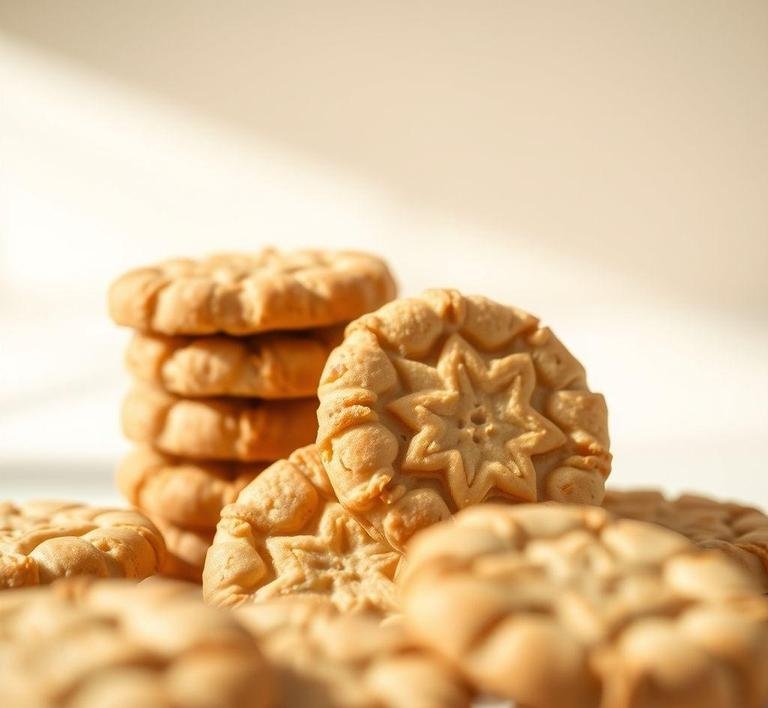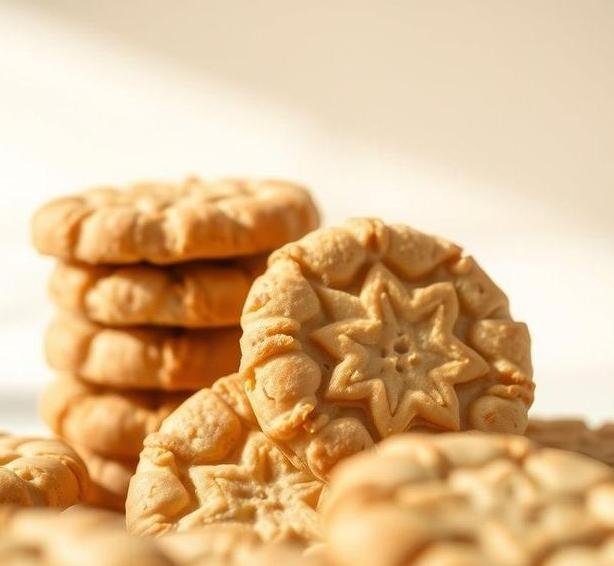Mary Berry’s Abbey Biscuits are a traditional British shortbread-style cookie with a light, crumbly texture and a subtle sweetness, often flavored with a hint of spice or citrus. These biscuits are inspired by old-fashioned recipes from abbeys and convents, where baking was a meditative and meticulous craft.
These delightful treats embody the comforting essence of home baking – not overly fancy, but deliciously nostalgic. They’re the kind of biscuit you’d enjoy with a proper cup of English tea on a quiet afternoon, or serve to guests when you want something understated yet undeniably delicious. The recipe reflects Mary Berry’s signature style: dependable, straightforward, and deeply satisfying.
They are crisp around the edges, delicately golden, and often adorned with a fork-pressed pattern or a light dusting of sugar. There’s something beautifully timeless about them – they wouldn’t be out of place in a countryside tea room or a village fête.
Mary Berry’s Abbey Biscuits Recipe
Ingredients Needed

The ingredient list for Abbey Biscuits is blessedly simple – part of what makes them such a cherished bake. You’re likely to have most of these items in your pantry already.
Dry Ingredients
- 100g (3½ oz) plain flour (all-purpose flour) – This is the base of your biscuit dough, giving structure.
- 50g (1¾ oz) caster sugar – For that delicate sweetness.
- 50g (1¾ oz) ground almonds – Adds richness and a subtle nutty flavor, making the biscuits tender and crumbly.
- ½ tsp ground cinnamon – Optional, but adds a warm, cozy note reminiscent of traditional bakes.
Fat
- 100g (3½ oz) butter (preferably unsalted), at room temperature – The star of the show; butter lends richness and helps achieve that signature melt-in-the-mouth texture.
Optional Toppings
- Demerara sugar – For a rustic sparkle and added crunch on top.
- A handful of flaked almonds – If you’d like to echo the almond flavor with a little flourish.
Equipment Needed
No need for fancy gadgets here – this is old-school baking at its finest.
- Mixing bowl – A large one to bring all your ingredients together comfortably.
- Wooden spoon or electric hand mixer – For creaming the butter and sugar.
- Weighing scales or measuring cups – Precision matters in baking, especially with flour and butter.
- Baking tray/sheet – Lightly greased or lined with parchment paper.
- Rolling pin – To roll out the dough evenly.
- Cookie cutter – A simple round one will do, or use a fluted edge for a more decorative look.
- Cooling rack – Essential for letting the biscuits set properly after baking.
- Fork (for patterning) – Optional, but traditional.
Instructions To Make Mary Berry’s Abbey Biscuits
Now for the fun part – let’s get baking!
Step 1: Preheat And Prepare
Preheat your oven to 180°C (160°C fan) / 350°F / Gas mark 4. Line a baking tray with parchment paper or lightly grease it to prevent sticking.
Step 2: Cream The Butter And Sugar
In your mixing bowl, cream together the softened butter and caster sugar until pale and fluffy. This introduces air into the mix, which helps make your biscuits light rather than dense.
Step 3: Add The Dry Ingredients
Stir in the plain flour, ground almonds, and (if using) ground cinnamon. Mix until the dough begins to come together. It may look crumbly at first, but keep going – it will form a soft, cohesive dough.
Step 4: Roll And Cut
Lightly flour your work surface and roll the dough to about 5mm (¼ inch) thickness. Use your cookie cutter to cut out rounds, and place them spaced slightly apart on the baking tray.
If you want that traditional Abbey Biscuit look, press lightly with a fork across the top to make a simple pattern. Alternatively, sprinkle a little demerara sugar or place a few flaked almonds on top before baking.
Step 5: Bake
Bake in the preheated oven for 10-12 minutes, or until the biscuits are lightly golden around the edges. Keep a close eye on them – they can go from golden to too-browned quickly.
Step 6: Cool And Enjoy
Remove from the oven and let the biscuits sit on the tray for 5 minutes – they’ll be very delicate fresh out of the oven. Then, carefully transfer to a wire cooling rack to cool completely.
Tips And Tricks
Here are some baking pearls of wisdom to help you master Mary Berry’s Abbey Biscuits:
1. Use Room Temperature Butter
This ensures easy creaming and a smooth dough. Cold butter won’t mix properly, and melted butter will ruin the texture.
2. Chill The Dough (Optional But Useful)
If your dough feels too soft to roll out cleanly, wrap it in cling film and chill for 15-20 minutes. This makes it easier to handle and helps the biscuits hold their shape.
3. Don’t Overmix
Once the flour is in, be gentle. Overworking the dough can make the biscuits tough.
4. Get Creative With Flavors
Try adding a touch of vanilla extract, a pinch of nutmeg, or a little lemon zest for a twist. You can even drizzle with a bit of icing for a fancier finish.
5. Storage
These biscuits store beautifully. Keep them in an airtight tin for up to a week – if they last that long! You can also freeze the unbaked dough for up to a month.
Mary Berry’s Abbey Biscuits are a masterclass in classic baking – unfussy, delightful, and full of charm. Whether you’re making them for a cozy weekend treat, a bake sale, or simply as a companion to your afternoon tea, these biscuits offer a taste of tradition that’s hard to resist. With their buttery richness, light crunch, and delicate almond flavor, they’re sure to become a favorite in your repertoire.
So go ahead – channel your inner Mary Berry, preheat the oven, and enjoy the meditative joy of creating something simple, beautiful, and oh-so-delicious from scratch.
Happy baking!
Easy Recipe Variations For Mary Berry’s Abbey Biscuits

Mary Berry’s original Abbey Biscuits are a marvel of simplicity, typically made with butter, flour, sugar, and a touch of spice like mixed spice or cinnamon. But once you’ve mastered the basic recipe, it opens a world of possibilities for creative twists! Here are some easy and delightful variations that keep the charm of the original while introducing exciting new flavors:
1. Citrus Zest Delight
Add the zest of one orange or lemon to the dough before baking. This adds a fragrant brightness that pairs beautifully with the buttery base of the biscuit. A little orange extract can enhance this variation even more.
2. Chocolate Chip Crunch
Fold in a handful of mini chocolate chips (dark or milk chocolate) into the dough. The chocolate brings a modern flair while still keeping the rustic feel. For a richer version, dip half the biscuit in melted dark chocolate and let it set.
3. Spiced Nut Variation
Try incorporating finely chopped toasted pecans or walnuts with a teaspoon of ground cinnamon or nutmeg. These additions give the biscuits a warm, nutty depth-perfect for autumnal baking.
4. Jam Thumbprints
Before baking, press a small well into the center of each biscuit and spoon in a tiny dollop of raspberry or strawberry jam. The result is a nostalgic, jam-filled delight reminiscent of a tea shop classic.
5. Herb & Honey Savoury Twist
For a completely different take, reduce the sugar slightly and add a teaspoon of finely chopped fresh rosemary and a drizzle of honey. These biscuits lean toward the savory side and pair wonderfully with a cheeseboard.
6. Gluten-Free Option
Replace the plain flour with a good-quality gluten-free blend (ideally one with xanthan gum already included). Abbey Biscuits are naturally quite forgiving, so a one-to-one substitution works well here.
Each of these variations allows you to tailor the classic recipe to suit different occasions-from cozy winter evenings to festive gatherings.
Storing Leftovers
If, by some miracle, you have any Abbey Biscuits left after the first day, proper storage is key to preserving their signature crispness and flavor.
1. Airtight Containers
Store your cooled biscuits in an airtight tin or a sealable glass jar. A classic biscuit tin lined with parchment paper is ideal-not just charming, but functional. Avoid plastic containers as they can cause the biscuits to soften.
2. Avoid Moisture
Humidity is the enemy of crisp biscuits. Keep them in a cool, dry cupboard, and avoid storing near the stove, kettle, or sink where moisture levels are high.
3. Reviving Soft Biscuits
If the biscuits do go a bit soft (perhaps left out during a long tea party!), they can be revived. Pop them in a low oven-around 140°C (275°F)-for 5 to 7 minutes. Let them cool completely, and they’ll be good as new.
4. Freezing For Later
Abbey Biscuits freeze surprisingly well. Arrange them in a single layer on a tray to freeze individually, then transfer them to a freezer-safe bag or container. When ready to eat, thaw them at room temperature or give them a quick refresh in a warm oven.
Stored correctly, these biscuits can last up to 5 days at room temperature or up to 3 months in the freezer-perfect for baking in batches ahead of time.
What To Eat With Mary Berry’s Abbey Biscuits?
One of the true joys of Abbey Biscuits is how incredibly versatile they are as a companion to a range of foods and drinks. Here’s how you can elevate your biscuit experience:
1. Traditional Teatime Pairings
- English Breakfast or Earl Grey Tea: The robustness of a black tea complements the subtle sweetness of the biscuits perfectly.
- Clotted Cream and Jam: Spread a little on top, and suddenly your Abbey Biscuits are edging toward scone territory-utterly indulgent!
2. With Cheese
Yes, really! A lightly spiced Abbey Biscuit (especially with added rosemary or nuts) pairs wonderfully with creamy cheeses like:
- Brie or Camembert
- Wensleydale with Cranberries
- A sharp aged cheddar for a sweet-and-savoury combo
3. Dessert Boards & Afternoon Platters
Abbey Biscuits make a stunning addition to:
- Dessert grazing boards with dried fruits, chocolate truffles, and mini meringues
- Afternoon tea stands alongside cucumber sandwiches, lemon drizzle slices, and Victoria sponge
4. Coffee Companions
These biscuits hold their own next to a strong cup of espresso or cappuccino. The slight sweetness balances the bitterness of the coffee, making it the ultimate mid-morning pick-me-up.
5. Crumbled Over Desserts
Use them creatively as a topping:
- Sprinkle over ice cream or yogurt
- Use crushed biscuits in a parfait or trifle for extra crunch
- Incorporate into cheesecake bases for a rustic twist
Conclusion
Mary Berry’s Abbey Biscuits are the epitome of understated British baking-simple, elegant, and endlessly adaptable. Whether you’re sticking to the traditional recipe or experimenting with citrus, chocolate, or herbs, these biscuits never fail to deliver comfort and charm. They’re the kind of bake that invites you to slow down, make a proper pot of tea, and savour the moment.
Best of all, they’re easy to store, freeze well, and pair beautifully with everything from a mug of tea to a decadent dessert board. Whether you’re entertaining guests or just treating yourself on a rainy afternoon, Abbey Biscuits deserve a spot in every home baker’s repertoire.
FAQs
What Are Abbey Biscuits, And How Are They Different From Other Biscuits?
Abbey Biscuits, a traditional British treat, are a type of sweet, buttery shortbread that Mary Berry has made famous. Unlike regular biscuits, these are typically thinner and more delicate in texture, often enhanced with a hint of almond or vanilla. The distinctive aspect of Abbey Biscuits is their clean, crisp edges and slightly chewy center, which makes them unique compared to thicker, crunchier biscuits like digestives or hobnobs.
What Ingredients Are Needed To Make Mary Berry’s Abbey Biscuits?
To make Mary Berry’s Abbey Biscuits, you’ll need the following ingredients: plain flour, unsalted butter, caster sugar, ground rice (for texture), and almond extract (for flavor). The simple list of ingredients comes together to form a rich, buttery dough that’s easy to prepare. The ground rice gives the biscuits a slightly sandy texture, which contributes to their unique bite.
How Long Do Abbey Biscuits Take To Bake, And What Temperature Should The Oven Be Set To?
Mary Berry recommends baking Abbey Biscuits in a preheated oven at 170°C (150°C fan) or 325°F for about 10-12 minutes. The biscuits should be golden brown at the edges, but slightly pale in the center. It’s essential not to overbake them, as they can become too dry. Let them cool on a wire rack to allow the texture to set perfectly.


